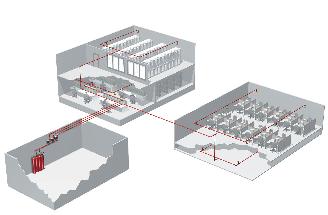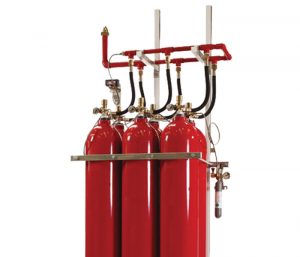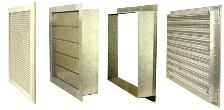Do You Have A Project We Can Help With?
Inert Gas – IG55, IG541 (INERGEN®)
Inert Gas Fire Suppression is a general term used to identify IG55, IG541, INERGEN®, IG-100 and IG-01.
Concept Fire Suppression’s standard Inert Gas Fire Suppression Agent is a 50:50 mix of two inert gases Nitrogen and Argon. Both gases occur naturally in the atmosphere and are therefore the ultimate in an environmentally safe fire suppression product that is also safe for people. They have a Global Warming Potential and Ozone Depleting Potential of zero and does not decompose on application to a flaming fire.
If you want to use INERGEN® you can use our IG541 equivalent.
The Inert Gas Suppression Agents
There are 4 types of agent generally available namely:
| Designated Name | Trade Name | Composition* |
|---|---|---|
| IG-01 | Argotec, Argonfire | Argon 100% |
| IG-55 | Argonite | Argon 50%, Nitrogen 50% |
| IG-541 | INERGEN® | Argon 40%, Nitrogen 52%, CO2 8% |
IG-01 and IG-100 are only occasionally used but the standard mixes of Argonite and INERGEN® are standard products, with most manufactures carrying stocks.
INERGEN® is the most widely known inert gas and people generally use it to describe all inert gases but as you can see from the table above it is only one product, but with very good marketing behind it. The addition of CO2 to the mix, the suppliers say this causes hyperventilation, thereby increasing oxygen intake. This also means an increase in the inhalation of combustion by-products that maybe harmful. INERGEN® has limited suppliers and therefore can be sometimes be expensive to refill. Concept Fire Suppression Ltd can supply new INERGEN® systems as well as have existing cylinders refilled or additional cylinders supplied.
Equally as good is IG55 which is the widest available with all manufacturers offering hardware using IG55. This mix is readily available to be refilled and therefore usually more cost effective than INERGEN® due to the large number suppliers. We can refill most makes of cylinder please contact us for details.
As Nitrogen, Argon and CO2 are stored as gases within the cylinders, to ensure sufficient agent can be stored it is stored in standard 80L cylinders at a pressure of 200 or 300 bar. The standard concentration of gas required for a class A fire is between 36.5% and 37.8% therefore for large rooms they require a fairly large space to store them. As an example a 750m3 room would require around 17 cylinders of IG55.
Design and Operation
As inert fire suppression systems are stored as gas it makes them very flexible allowing us to design systems with multiple banks of cylinders protecting multiple enclosures. This negates the need for individual banks of cylinders for each enclosure. Using directional valves multiple rooms can be piped back to a central bank of cylinders and when a detector detects a fire the correct valve is operated and the gas will be discharged into the correct enclosure. Also, cylinders can be stored away from the protected enclosure within a plant room or storage area thereby making more efficient use of operational space (see below).

Inert gases work on the principle of reducing the oxygen content within the room from the normal approximately 21% by volume to below 15%, the point at which a fire cannot be sustained. Typically we design to around 12.5% which does not allow the fire to sustain itself but is still safe for up to 10 minutes for people to be present. When a fire has been detected and before a system is discharged we strongly recommend that everyone is evacuated for health and safety reasons.
Hardware
 As manufacturers can only differentiate on hardware, as the agent is basically the same they have come up with a few simple and sometimes very innovative ideas to differentiate the products.
As manufacturers can only differentiate on hardware, as the agent is basically the same they have come up with a few simple and sometimes very innovative ideas to differentiate the products.
The original way to reduce the pressure from 200 or 300 bar to around 45 bar is to use an orifice plate, which basically looks like a large washer. It works on the principle that by restricting the flow through the pipework when the gas gets past the orifice plate and into a larger pipe, the pressure is reduced. This works well but the pipework between the cylinder and the orifice plate needs to be designed to operate at much higher pressures than the pipework after the plate.
New developments mean that companies have now developed self regulating valves. These new valves reduce the pressure down to 45 bar therefore negating the need for high pressure pipework needed for the older orifice system and standard gas fire suppression pipework can be used throughout. This means that the gas is discharged more evenly, puts less pressure on the room and thereby reducing the size of the Over Pressure Vents.
Over Pressure Venting
 All inert gas systems must have Over Pressure Vents fitted to protect the room from damage during a discharge. As we discharge around 40% more gas into the room than was originally there, the room needs to be able to vent to atmosphere to protect the walls, ceilings and doors from damage (see adjacent picture). The gas discharges over a period of a minute and starts immediately to build up a positive pressure within the room, the vents allow this to dissipate through the specially weighted blades so that no interconnection between the fire detection and suppression system is necessary. We offer a full range of sizes from 200mm2 to 1000mm2 and providing multiple vents where required.
All inert gas systems must have Over Pressure Vents fitted to protect the room from damage during a discharge. As we discharge around 40% more gas into the room than was originally there, the room needs to be able to vent to atmosphere to protect the walls, ceilings and doors from damage (see adjacent picture). The gas discharges over a period of a minute and starts immediately to build up a positive pressure within the room, the vents allow this to dissipate through the specially weighted blades so that no interconnection between the fire detection and suppression system is necessary. We offer a full range of sizes from 200mm2 to 1000mm2 and providing multiple vents where required.
Room Integrity Testing
A Room Integrity Test will ensure that the room will contain the inert gas for as long as possible (BS EN 15004 stipulates a minimum of 10 minutes). Before this test is carried out all the entry points for cables and pipes in the walls, floor and ceiling must be sealed. . The sealing is done using fire proof materials to ensure no gas will escape during the discharge and the concentration level will be held for 10 minutes to suppress the fire.
To download the brochure click here




